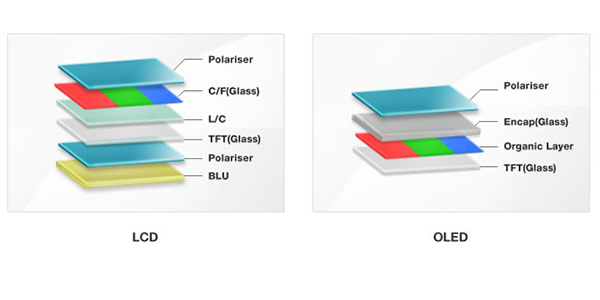The advantages and disadvantages of LCD screens and OLED screens
Blaze Display Technology Co., Ltd. | Updated: Nov 27, 2018
In today's electronic products such as smartphones, tablets and TVs, we often hear discussions about LCD screens and OLED screens. Both screen technologies have their strengths, but there are also some differences.

1. LCD screen (Liquid Crystal Display)
LCD (Liquid Crystal Display) screen is a display technology that uses liquid crystal material as the optically active layer. The following are the advantages and disadvantages of LCD screens:
Advantage:
(1) The pixel density is high, and the display effect is delicate.
(2) Capable of high brightness and strong backlighting, suitable for outdoor environments.
(3) It can provide more accurate color performance and is suitable for the display of images and videos.
(4) The energy consumption is relatively low, prolonging the battery life of the device.
(5) In static display for a long time, there is no pixel aging problem.
Disadvantage:
(1) The complete black cannot be achieved because of the need for a backlight.
(2) Viewing angles are limited, with color shifts and reduced brightness when viewed from the side or up and down.
(3) Thicker than OLED screens because of the need for an additional backlight module.
2. OLED screen (Organic Light Emitting Diode Display)
OLED (Organic Light Emitting Diode) screen is a display technology that uses organic materials as the light emitting layer. Here are the advantage and disadvantage of OLED screens:
Advantage:
(1) The Complete black can be achieved because each pixel has an independent light emitting function.
(2) Wide viewing angle, when the viewing angle is greatly increased, there will be no color change and brightness reduction.
(3) Responsive, with a higher refresh rate and response time.
(4) Energy consumption is low, and only consumes more power when the brightness is high.
(5) Thinner type, suitable for thin and light device design.
Disadvantage:
(1) There is a pixel aging problem, and long-term static display may cause some areas to lose their ability to emit light.
(2) Displays have a relatively short lifespan and are prone to color distortion and brightness decay.
(3) Visibility is poor outdoors in direct sunlight.
(4) Higher cost, more expensive compared to LCD screens.
LCD screens and OLED screens have their own advantages and disadvantages. LCD screens are suitable for scenes that require high brightness and accurate color performance, while OLED screens have advantages in complete black, wide viewing angles, and response speed. When choosing a screen technology, you can decide based on your specific needs and budget. With the continuous advancement of technology, we believe that these two screen technologies will have even better development.

